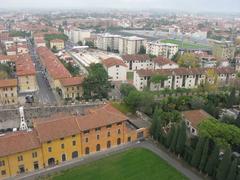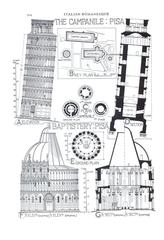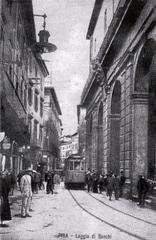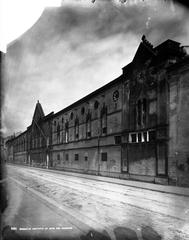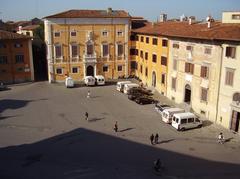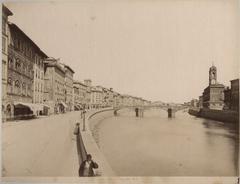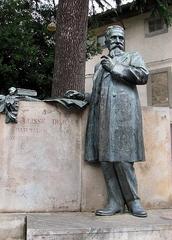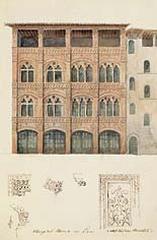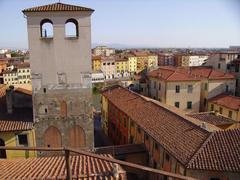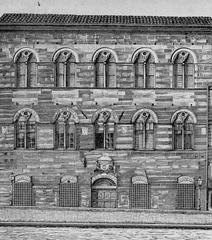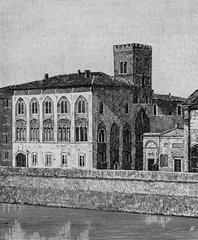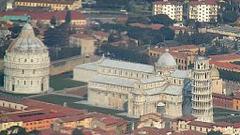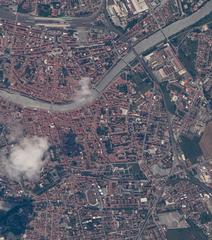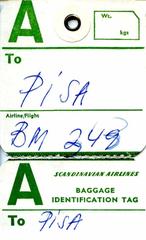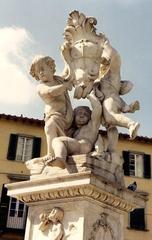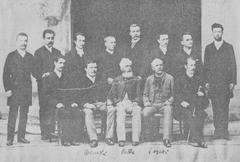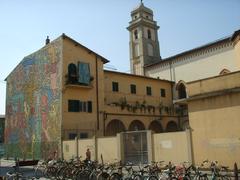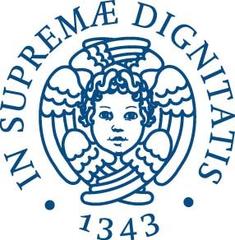
Santo Sepolcro Pisa: Comprehensive Guide to Visiting Hours, Tickets, and Historical Insights
Date: 04/07/2025
Introduction
The Church of Santo Sepolcro in Pisa is a remarkable medieval monument that reflects the city’s profound connections to the Crusader era, maritime history, and religious devotion. Established in the early 12th century and attributed to the architect Diotisalvi—also known for Pisa’s Baptistery—Santo Sepolcro’s octagonal architecture uniquely mirrors Jerusalem’s Church of the Holy Sepulchre, symbolizing resurrection and spiritual renewal. More than a place of worship, it also served as a hospital and hostel, historically managed by the Knights Hospitaller, and stands today as a serene counterpart to Pisa’s more frequented basilicas.
Strategically located near the Arno River and close to major landmarks such as the Leaning Tower and Pisa Cathedral, Santo Sepolcro offers a contemplative and culturally rich experience for travelers. This detailed guide covers its history, architectural features, visiting hours, ticketing, accessibility, and travel tips to ensure you make the most of your visit. For additional resources, see the Pisa Tourism Website and the Pisa Tourism Portal.
Contents
- Historical Background
- Architectural Design and Symbolism
- Artistic and Interior Highlights
- Practical Visitor Information
- Travel Tips and Nearby Attractions
- Accessibility
- Frequently Asked Questions (FAQ)
- Conclusion and Final Tips
- Sources
Historical Background
Early Origins and Foundation
Santo Sepolcro was first documented in 1113 and constructed during Pisa’s medieval expansion in the Chinzica quarter, just outside the old city walls and near the Arno. Its establishment coincided with Pisa’s significant involvement in the Crusades, and the church’s design deliberately echoes the Church of the Holy Sepulchre in Jerusalem—both as a spiritual homage and as a symbolic gateway for pilgrims unable to travel to the Holy Land. The church also functioned as a hospital and hostel, reflecting the city’s status as a hub for trade, pilgrimage, and care.
Religious Orders and Civic Role
Unlike common misconceptions tying it to the Knights Templar, Santo Sepolcro was founded and run by the Knights Hospitaller (Order of St. John of Jerusalem), whose mission included caring for the sick and accommodating travelers. This complex, which included a convent and hospital, played a vital role in Pisa’s medieval religious and social life, serving both locals and passing pilgrims (Wikipedia: Santo Sepolcro, Pisa; Love From Tuscany).
Architectural Patronage and Evolution
The church’s design is attributed to Diotisalvi, a renowned Pisan architect. Its octagonal plan was innovative for the time and drew on influences from the Holy Land, particularly the Dome of the Rock and the Church of the Holy Sepulchre. Over the centuries, Santo Sepolcro underwent several transformations: Baroque-style refurbishments in the 18th century and a significant 19th-century restoration that aimed to recover its original medieval appearance by removing later additions and restoring the lower floor level (Terre di Pisa).
Architectural Design and Symbolism
Exterior Features
Santo Sepolcro’s octagonal shape is its most distinctive feature, symbolizing resurrection and spiritual renewal, with the number eight holding particular significance in Christian numerology. The exterior is built of local stone with alternating bands of white and grey, typical of Pisan Romanesque style. Each side of the octagon features two windows, and the building is capped by a conical roof with a lantern that allows natural light to illuminate the interior (Love From Tuscany; Wikipedia).
A 19th-century bust of Diotisalvi by Sante Varni marks the main entrance. The nearby bell tower, made from stone and brick with small arches and a mullioned window, stands as a testament to the church’s medieval engineering (Lost Story).
Interior Layout and Atmosphere
Inside, eight massive pillars support the luminous pyramidal dome. The central altar and the geometric harmony of the space create a tranquil and contemplative atmosphere. The interplay of natural light and the simplicity of the design draw focus to the church’s spiritual symbolism, making it ideal for peaceful reflection (Evendo).
Artistic Elements
Significant artistic details include original Romanesque capitals with stylized foliage and geometric motifs, reflecting cross-cultural influences from Byzantine and Islamic art. The north and south entrances are adorned with 12th-century animal motifs. The church’s original altar and relics, including a copy of the Holy Sepulchre, once served as a focal point for local devotion (Love From Tuscany).
Notable Interior Highlights
- Tomb of Maria Mancini: Burial site of the niece of Cardinal Mazarin and former favorite of Louis XIV, linking the church to European nobility (Terre di Pisa).
- Well of Santa Ubaldesca: This 12th-century well is associated with a local miracle attributed to Santa Ubaldesca, who allegedly turned water into wine (Nomads Travel Guide).
- Bust-Relic of Santa Ubaldesca: A 15th-century reliquary commemorates this local saint, celebrated for her compassion and miracles.
Practical Visitor Information
Visiting Hours
- Standard Hours: Open to the public in the afternoons, typically from 3:30 pm to 5:00 pm. Hours may vary for holidays or special events.
- Always Check Before Visiting: Verify the latest opening times via the official Pisa tourism website or Terre di Pisa.
Tickets and Admission
- Admission is free, although donations for maintenance and preservation are appreciated.
- Guided tours and audio guides may incur a fee and can be booked online or on-site.
Guided Tours & Special Events
- Guided tours are occasionally available and provide deeper historical and architectural context. Check with the Pisa tourism office or local guides for details.
- The church may host special religious or cultural events, particularly around major Christian holidays.
How to Get There
- Walking: About 20 minutes from Pisa Centrale railway station.
- Bus: Lines 5 or 21 from Pisa Centrale stop at ‘Santo Sepolcro’.
- Bicycle: Pisa is bike-friendly; the route from the station is quick and scenic (Evendo).
Accessibility
- Wheelchair Access: The church is generally accessible via the main entrance, but the interior has uneven medieval flooring. Visitors with mobility concerns are encouraged to contact the Pisa tourist office in advance.
- Location: Situated on a flat piazza, making approach relatively easy for most visitors.
Travel Tips and Nearby Attractions
- Combine Visits: Plan to visit Santo Sepolcro alongside Pisa’s other iconic sites, such as the Leaning Tower of Pisa, Pisa Cathedral, and National Museum of San Matteo.
- Dress Appropriately: Modest attire, covering shoulders and knees, is recommended.
- Enjoy Riverside Cafes: The church’s neighborhood offers charming cafes for a relaxing break.
- Photography: Permitted both inside and outside; the church’s geometry and lighting are ideal for photography.
Frequently Asked Questions (FAQ)
Q: What are the Santo Sepolcro visiting hours?
A: Typically open afternoons from 3:30 pm to 5:00 pm; always check current hours before visiting.
Q: Is admission free?
A: Yes, entry is free, but donations are welcomed.
Q: Are guided tours available?
A: Yes, they are occasionally offered. Contact local tourist offices for schedules.
Q: Is Santo Sepolcro wheelchair accessible?
A: There is general access via the main entrance, but the interior has uneven flooring.
Q: Can I take photographs?
A: Yes, photography is permitted. Please be respectful of the sacred atmosphere.
Q: What are the best times to visit?
A: Early afternoon on weekdays is typically less crowded.
Q: What other attractions are nearby?
A: Piazza dei Miracoli (Leaning Tower, Cathedral, Baptistery), Borgo Stretto, and the Arno riverside are all within walking distance (Wide World Trips).
Conclusion and Final Tips
Santo Sepolcro is a hidden gem that combines medieval architecture, Crusader history, and spiritual symbolism. Its octagonal form, inspired by Jerusalem’s Holy Sepulchre, and its tranquil interior offer a unique experience beyond Pisa’s main tourist sites. Free admission, occasional guided tours, and proximity to other landmarks make it an essential stop for those seeking to enrich their understanding of Pisa’s cultural and religious heritage.
To maximize your visit:
- Plan for afternoon hours and check for any updates.
- Dress modestly.
- Combine with nearby attractions for a full day of exploration.
For ongoing updates and immersive experiences, consult official resources such as the Comune di Pisa Cultural Heritage and Terre di Pisa.
Sources
- Official Pisa Tourism Website
- Pisa Tourism Portal
- Comune di Pisa Cultural Heritage
- Terre di Pisa
- Wikipedia: Santo Sepolcro, Pisa
- Love From Tuscany
- Evendo
- Nomads Travel Guide
- Visitsights
- Wide World Trips



